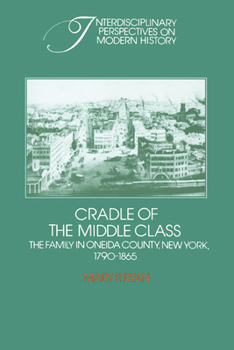Cradle of the Middle Class: The Family in Oneida County, New York, 1790-1865
Select Format
Select Condition 
Book Overview
Focusing primarily on the middle class, this study delineates the social, intellectual and psychological transformation of the American family from 1780-1865. Examines the emergence of the privatized middle-class family with its sharp division of male and female roles.
Format:Paperback
Language:English
ISBN:0521274036
ISBN13:9780521274036
Release Date:January 2008
Publisher:Cambridge University Press
Length:336 Pages
Weight:0.98 lbs.
Dimensions:0.8" x 6.2" x 8.9"
Customer Reviews
3 ratings
couldn't put it down
Published by Thriftbooks.com User , 16 years ago
She ties together big-picture economic changes, religious revivals, child-rearing strategies, the emergence of privacy, the separation of public and private spheres, and the loosening grip of family ties -- all without losing touch with specific people and places. I had no idea, for instance, how "a fine network of kin relationships was superimposed upon the factory order of New York Mills. One set of employment records dating from 1826 was actually arranged into family units. This ledger detailed the work experience of some twenty families, all identified by the name of the father or occasionally a widowed mother at the top of the page." http://midwesternmicrohistory.blogspot.com
A Fascinating Portrait of the Evolution of the Victorian Family
Published by Thriftbooks.com User , 18 years ago
When Mary P. Ryan's local study of the transformation of Oneida County, New York, from an agricultural to an industrial society appeared in 1981 it sparked a debate about the nature of the American family that has yet to abate. Ryan argues that changes in family structure as a result of this economic transformation created the Victorian culture of the latter half of the nineteenth century. She offers a complex, and richly drawn, exploration of how the family moved from the farm to the factory. It is, without question, an important consideration of changes n the American family and the costs of those changes. The movement from the patriarchal society of an agricultural society to one that was industrial and commercial altered the perspectives of both men and women. She suggests that in the agricultural society of the early Republic, the family rested on the use of "productive property, a domestic division of labor, and generational continuity" (p. 231). With the rise of a new economy, and the changes it necessitated, Ryan insists that there was a bifurcation of gender roles that emphasized a cult of domesticity for women as well as a male-oriented "bread-winner" emphasis. The middle class, the focus of this study, reflected these changes more dramatically than other segments of the population and Ryan explores this in some detail. She comments that the social reform movements of the antebellum era also fundamentally influenced the construction of this new middle class society. Ryan notes several key changes to the nuclear family that resulted from this dynamic. First, she found a change in the mother-child relationship as the "central place in the constellation of family affection" and a lessening role of the father in child-rearing (p. 233). He was still present as a disciplinarian, but his patriarchal place found less grounding with each year. Ryan also argues that the home became a place of domesticity in which women and children had more authority than ever before. She notes that this ensured a "less subjugated status, within the home combined with their increasing alienation from external sources of economic and social power" (p. 233). Ryan comments on how women used benevolent organizations, religious groups, and other institutions to establish and protect family norms that would be identified as thoroughly Victorian. For men, the external sphere became increasing male. There is much to praise in "Cradle of the Middle Class," but one caution is in order. The centerpiece of this book is a discussion of the modern middle class and how it came into being, but Ryan does not carefully define the middle class. That has long been a problem in the history of classes, and if one believes that they are middle class most observers seem to accept it. But her definition of the middle class in the preface as "farmers, artisans, and shopkeepers" (p. vii) does not square with her later definition as "salaried white-collar workers, the managers, salesme
Pioneering Work in 19th-Century History
Published by Thriftbooks.com User , 22 years ago
Ryan's Cradle of the Middle Class broke new ground when it was published in '81, forcing historians to rethink the rise of the middle class, placing it into its historical context and at the same time arguing that the retreat to the middle-class home was a choice, for both men and women. Often held up as a classic of women's history, what makes this book amazing is that it's also pioneering in men's history, examining the effect of the domestic sphere on both boys and girls, men and women, and the social, cultural, economic and religious forces that led to their identification with the domestic sphere as the source of moral strength. Ryan gives a clear view of the complex interactions of economic and political change with personal relationships, literature and other social factors in creating the idea of the 'middle class.' She uses a wide variety of sources, including private letters and personal portraits which give oyu an idea of the real people who made these decisions, and it's becautifully organized & well written. For anyone interested in an academic book examining the middle class, the domestic sphere, or the family in the 19th century, this is a great read-- I've read it three times for different graduate classes, and I still like it (and THAT'S a compliment...) :)






